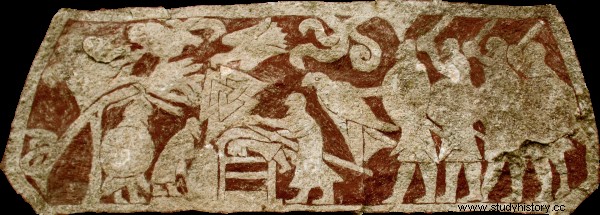All of England and France lived in fear of their brutality. Viking torture has become an infamous symbol of pagan bestiality. Bloody eagle, gutting enemies ... But what's the truth about Viking torture? And which of them were the worst?
One thing is certain:the black legend preceded the warriors of the North wherever they went. The stories of torture and murdering festivals organized by the Vikings during their military expeditions caused such fear among the inhabitants of Christian Europe that often, at the mere sight of characteristic ships, they simply ran away. Even Charlemagne, hearing about the fleet approaching his country's borders, was to - according to biographers - shed tears. What was so feared?
The eagle that was not there
The most drastic torture (and at the same time a method of execution) attributed to the Vikings today was the so-called "bloody eagle". The originator of this ritualistic method of killing the victim must have been endowed with an exceptionally sadistic imagination. Cutting out the eagle consisted in ... cutting out the ribs from the back side with an ax, and then dragging them outside . The final "decoration" were the lungs of the unfortunate, which were opened on his open chest to resemble wings.
It was by this method, according to the descriptions of numerous authors of the sagas about the people of the North, that Ivar the Boneless was to avenge the death of his father. Skald Sigvat in his poem dated 1030 reported:“Ivar, who resided in York, cut an eagle on Aella's back [of Northumbria - ed. ed.] ”, which was later picked up by subsequent biographers and poets. The "Saga of the Orkneys" from 1200 already contains a complete description of the ritual - and not by Ivar himself, but also by other Vikings.

For years this scene from the Stora Hammars stone was thought to represent the torture of a "blood eagle".
How much truth is there in these stories? Well the eagle has been associated with victory for centuries so the leaders of the northern peoples must have had his image on their banners. This is how the emblem of the famous Ragnar Bernard Cornwell describes in the novel "Bringer of the Storm", the second part of the best-selling series "Viking Wars":
I finally saw one of the last Danish groups defending themselves against a horde of advancing Saxons. I ran towards them, and suddenly I recognized the banner under which they were fighting. The eagle's wing. It was Ragnar.
This does not mean, however, that they immortalized the symbol of the proud bird also on the bodies of their enemies. Modern historians agree that this kind of torture could not be used on a regular basis. Why? First, the victim would have died in the early stages of the blood loss , long before the "decoration" is complete. Second, it is very likely that the whole story was just made up!
Researchers speculate that Sigvat could have simply used the metaphor of an eagle hitting prey (the bird would, of course, be Ivar, and the hunted would be Aella). What about the scenes carved into the Stora Hammars stone of Gotland that have long been interpreted as evidence of this drastic torture? Already in the 1980s, criticism of this hypothesis appeared in the scientific press. Yale University historian Roberta Frank has argued, for example, that the younger the reports of the executions, the more brutal they are.
It is possible, therefore, that the "blood eagle" was merely a fairy tale invented by Christians, resulting from a wrong translation and panic. According to the competing theory the bird of prey was not cut out, but drawn on the back of a defeated opponent to show your domination. But the fact that the most famous Viking torture turned out to be a misinterpretation does not mean that the warriors from the North did not know and did not use other drastic methods ...

This article was inspired by the second volume of Bernard Cornwell's "Viking Wars" saga, entitled "The Storm Bringer", published by Otwarte publishing house.
King Edmund and the tree of torture
Also in this way of bullying the enemy, the main character (or rather:the executioner) was Ivar, who was often called "the most brutal of Viking leaders". In 870, after defeating King Edmund's army in East Anglia, he wished the captured European ruler to renounce his faith. So he instructed his warriors to tie him to a tree and flog him . When that didn't help - Edmund was supposed to call on Christ all the time, which in such a situation does not seem particularly strange - the monarch was thrown with stones and then treated as a shooting target. Eventually resigned, Ivar had the victim beheaded.
The story of Edmund's execution spread quickly throughout Europe. And on the basis of these stories between the years 985 and 987, that is, more than a hundred years later, the biography of the ruler was created. By that time, the descriptions of Viking cruelty had already taken on a very exalted character. For example, they have been accused of deliberately recreating the martyrdom of the crucified Christ and of Saint Sebastian, who was streaked with arrows.
The problem was that the northern peoples of the time could not know the Christian saints, so even if the resemblance did exist, it was entirely coincidental. Author of Passio Sancti Eadmundi , Abbo of Fleury, also wrote that after the flogging the skin on the king's back cracked and the ribs became visible which in turn resembled a "bloody eagle", so we already have a full set of atrocities ... Apparently, the galloping imagination, fear and the passage of time played a significant role here again. We will probably never know how the unlucky ruler actually did his life.
The tree as a central element of torture and execution appeared in the case of yet another method - evisceration, which is also considered to be a way of inflicting deaths liked by the Vikings. According to the Saga of Njalu written in the 13th century after the Battle of Clontarf in 1014, the apostate Brodir and his men were captured. The torturer was a "converted" warrior Ulf Niespokojny. He tore Brodir's belly and then dashed him around the trunk until all the insides were outside (only then was the victim going to die).

A fragment of a 12th-century miniature depicting the martyrdom of King Edmund.
The whole story is very perverse. On the one hand, we have a Viking-Christian killing a Viking-pagan who also rejected Christianity after his ordination. On the other hand, the very method of execution resembles a sacrificial ritual in honor of the god Odin. So what was Ulf's true intention when deciding how to punish the apostate? Again, historians can only speculate on this point…
A serpent in the wicked
Olaf I Tryggvason - like Ulf - was a great supporter of Christianity and decided to introduce a new faith by force. It is not hard to imagine that the king's subversive idea met stiff resistance in Norway. The fact that Olaf at the very beginning of his campaign locked 80 pagans in the temple and burned them alive certainly did not help to ease the conflict. .
Rauda of Salten also found out how ruthless he was towards those resistant to Christianization. The ruler promised him "the worst possible death" if he would not accept Christ's teachings. After another refusal, he ordered Raud to put a piece of wood between his teeth and then tried to shove a… poisonous snake into the victim's mouth.
As reported by the poet and historian Snorri Sturlson, the clever Norwegian blew on the animal, so the treatment failed. Then Olaf slipped a branch of an angelica into Raud's throat and let the reptile through it , additionally driving him with a hot iron.

Olaf I Tryggvason Christianized his people by force. And he did not hesitate to use torture for this purpose.
As for the final result of the execution, various conjectures can be made. Snorri recorded that the snake "crawled into Raud's mouth and down his throat until it had a hole in his side and Raud died." However, this seems rather unlikely. If a suitably thick hose did get deep into the mouth, the victim would simply suffocate.
Possibly the scared reptile might have bitten Raud; the effect would then depend on the species of snake. Naturally, there was a zig-zag viper on the Scandinavian Peninsula at that time, but it is possible that the Norwegian king had at his disposal a more exotic "tool" of execution. There is also a chance that the whole situation was made up , and the scene of the abuse of Raud and the god of spirit the guilty serpent was an allegory of the Christianization terror that Olaf had brought to Scandinavia.
Brutal… performances?
When diverse cultures with deeply rooted traditions and rituals come into contact, exaggerations and distortions often occur. On this basis, legends are later formed - such as those created when Christians from Europe "got to know" the peoples of the North.
The Vikings did not know the concept of holiness, they treated monasteries as easy cells filled with valuable loot. That is why the authors of texts from that time (mainly Christians) gave them very dark features. Meanwhile, most of the victims of Scandinavian invaders died completely "standard" - in combat or due to difficult conditions in captivity.

The inspiration for this article was the second volume of Bernard Cornwell's "Viking Wars" saga, entitled "Herald of the Storm", published by Otwarte publishing house.
However, it is relatively easy to follow the mind of an observer of religious rituals who came from a monastery among the Vikings. Northerners, for example, had the habit of nailing dead animals consecrated to the gods to trees. As Adam of Bremen wrote in the 11th century, pagans offered male sacrifices in the sacred grove - one of each species, including horse, dog, and even human.
From the Oserberg cloth, it is concluded that the Vikings also liked to hang their victims. It was a peculiar tribute to Odin - the patron saint of hangmen, who had the ability to talk to the dead. Snorri also mentions a special form of ritual to tame the deities consisting of a "false" sacrifice from the leader. When no prayers helped in a difficult period, the local ruler was "hung" on a rope made of a calf's intestine and "pierced" with a reed by a priest.
Since the peoples of the North have resorted to such depictions in their struggle to survive, it is more than likely that most of the legends about their bestiality have been ... made up. As for the torture itself, it was in every way inferior to that of the Christian Inquisition shortly thereafter.
Inspiration:
This article was inspired by Bernard Cornwell's novel "Zwiastun Burzy", which was published by Otwarte publishing house. This is the second volume of the best-selling series about the turbulent times of the Viking invasions of England in the 9th century.
Buy the book cheaper on the publisher's website:

